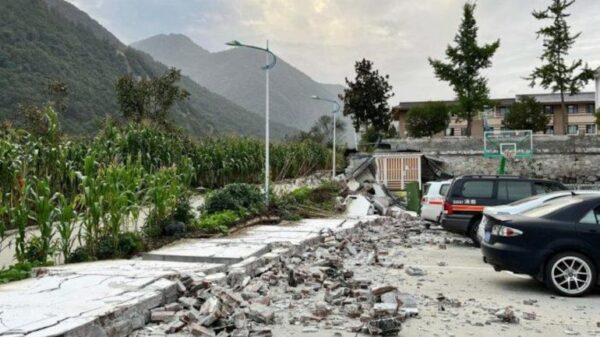At least 46 people were killed and several others were injured on Monday when a strong earthquake of 6,8-Magnitudo jerked luding county in the Southwest Sichuan province of China, whose population was staggered under the increasing number of Covid-19 cases and drought that had not yet ever happened before.
The epicenter of the quake, which is Occurred at 12:25 pm local time, was monitored at 29.59 Degrees North Latitude and 102.08 Degrees East Longitude at a Depth of 16-Km, China Earthquake Networks Center Was Was. news agency. Epicenter is 39 km from the County Luding seat and there are several villages in the range of 5-KM around the epicenter.
The official media report quoted local officials who said that at least 46 people were killed and more than 50 others were injured. Victims are expected to rise because the rescue team fans to the affected area. Among the dead, 29 came from the Ganzi Tibetan autonomy prefecture, which managed Luding County, and 17 others came from the City of Ya’an.
Most people from more than 21 million strong Chengdu populations spend most of the days outside their homes when aftershocks continue to shake the area. Infrastructure, including water, electricity, transportation and telecommunications services, are also damaged. “Sincere condolences for the lives of lost in the devastating earthquake in Sichuan on September 5 and prayers for the initial recovery of injured,” the Indian embassy here tweeted.
PREZ ORDERS RESCUE EFFORTS
Chinese President Xi Jinping has ordered an all-out rescue effort to minimize victims, emphasizing that saving lives must be taken as the main task. XI stressed the strengthening of earthquake monitoring, maintaining the secondary disaster and accommodating those affected correctly.
When calling for the best efforts to ensure the safety of people’s life and property, XI asked the Ministry of Emergency Management and other departments to send a team to Sichuan to guide the work of assistance and order the people’s liberation army and the People’s Armed Police to actively assist local disaster assistance efforts.
Premier Li Keqiang also urged a rapid evaluation of this situation, as well as an all-out medical rescue and care effort. The Red Cross Society of China initiated the level of Emergency Level-III after the earthquake, with the first batch of aid material consisting of 320 tents, 2,200 aid packages, 1,200 blankets and 300 folding beds sent to affected areas. The community has also sent a working group there to help with assistance and rescue work.
Sichuan Province has activated the second highest emergency response rate for earthquakes and more rescue troops rushed to the epicenter area. The vibration was felt in Chengdu, the capital of Sichuan, which is 226 km from the epicenter. Photos and videos posted on Chinese social media show shaking buildings in Chengdu. The details of the damage awaited.
Sichuan Province is located close to Tibetan. The Tibetan plateau is known to be vulnerable to heavy earthquakes because it is right above the place where Eurasian and Indian tectonic plates meet, often colliding with great force.
More than 69,000 people were killed when the 8.2 earthquake struck the province in 2008 and an earthquake of magnitude 7 claimed 200 lives in 2013. The Monday earthquake struck the province wrestling with an increase in the number of COVID-19 cases.
Chengdu is under locking snap because more and more cases. Residents are told to stay at home, with one person per household permitted to go out every day to buy needs. The daily nucleic acid test was also mandated until Wednesday, the South China Morning Post based in Hong Kong reported.
More than 1,000 cases have been reported since mid -August in Chengdu alone, the southwest transportation center consisting of 21 million people. Sichuan reported 105 cases of new symptoms on Monday and 80 infections without other symptoms. The province is also staggered under drought that has never happened before and the heat waves survive above the vast Chinese plots, with agricultural land left dry after a month there is no rainfall and there is a little or no irrigation equipment available to farmers.
